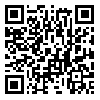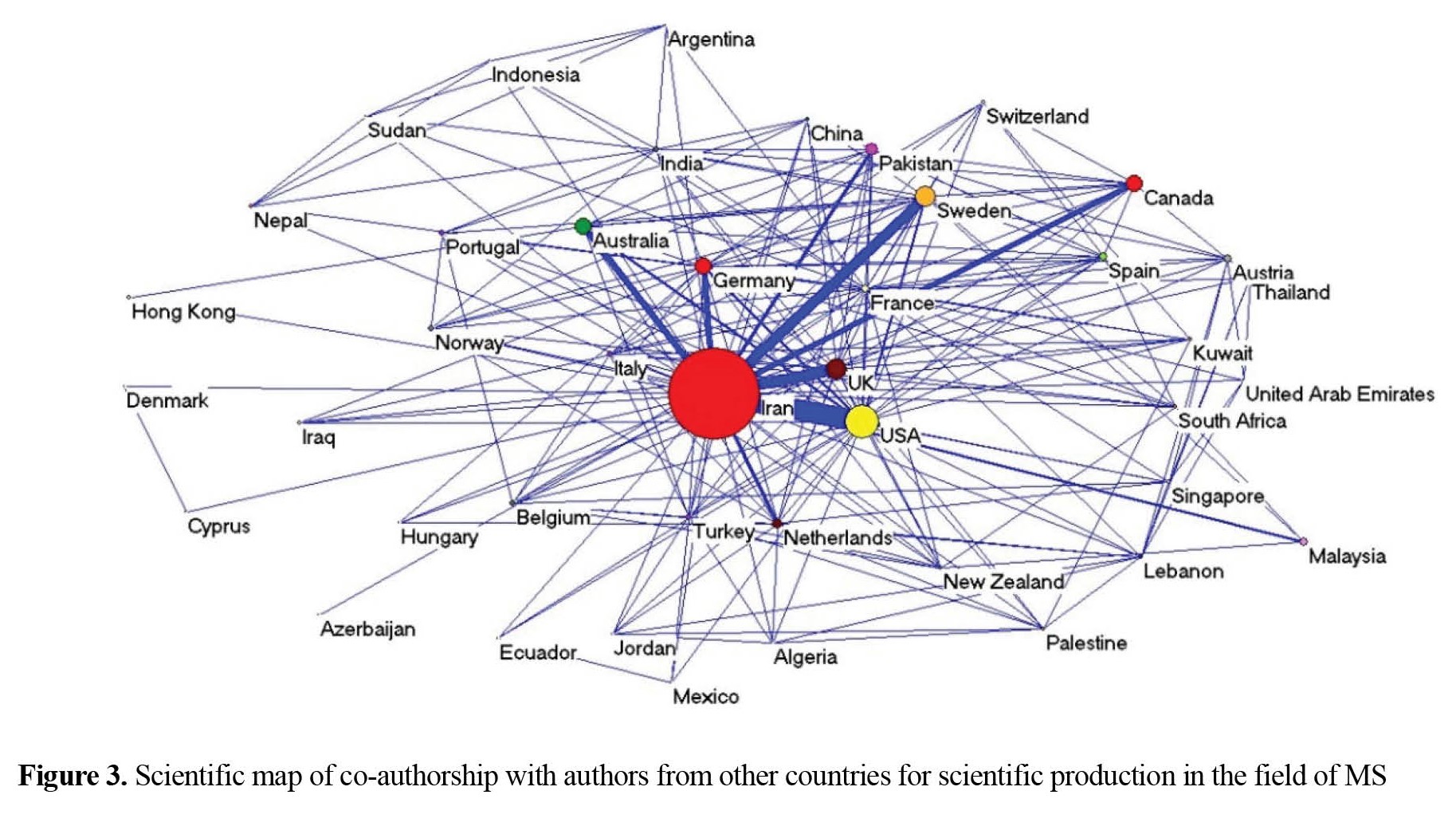Volume 9, Issue 3 (Autumn 2023)
JMIS 2023, 9(3): 278-295 |
Back to browse issues page
Download citation:
BibTeX | RIS | EndNote | Medlars | ProCite | Reference Manager | RefWorks
Send citation to:



BibTeX | RIS | EndNote | Medlars | ProCite | Reference Manager | RefWorks
Send citation to:
Giti A, Golchin M, Babaee T, Fassihi A. Mapping a Scientific Map of Researchers in the Field of Multiple Sclerosis (MS) Publications. JMIS 2023; 9 (3) :278-295
URL: http://jmis.hums.ac.ir/article-1-441-en.html
URL: http://jmis.hums.ac.ir/article-1-441-en.html
University of Social Welfare and Rehabilitation Sciences, Tehran, Iran.
Full-Text [PDF 6865 kb]
(851 Downloads)
| Abstract (HTML) (1487 Views)
Conclusion
According to the results of this study, the publications on MS have a growing and upward trend. Wang [10], Riahi et al. [13] and. Dehghanbanadaki et al. [11] also reported an upward trend in their studies. Patil [7], Zhai et al. [6] and Ye et al. [9] in their studies found that China and the United States had conducted the most studies in the field of COVID-19. Among the universities, the University of Hong Kong has the highest production rate and among researchers, Yuen Kwok Yung was in the first place. They suggested that international scientific cooperation is necessary for accelerating research progress and achieving scientific success. In our study, the results showed that the article titled “MEGA5: Molecular Evolutionary Genetics Analysis Using Maximum Likelihood, Evolutionary Distance, and Maximum Parsimony Methods” was the most cited article in the field of MS with 27269 citations. Kim MS was the most prolific author with 14503 articles. Most of the articles were published in the Multiple Sclerosis Journal with IF=5.81. The Lipro University was the most prolific institution.
Ethical Considerations
Compliance with ethical guidelines
This study has ethical approval from Hamedan University of Medical Sciences.
Funding
This research did not receive any specific grant from funding agencies in the public, commercial, or not-for-profit sectors.
Authors' contributions
Data collection: Marzieh Golchin and Anahita Giti; Data analysis: Anahita Giti; Writing: Tahmineh Babaee and Aileen Fassihi.
Conflicts of interest
The authors declared no conflict of interest.
Acknowledgments
The authors would like to thank Dr. Robab Teymouri, for her assistance in this study.
Full-Text: (948 Views)
Introduction
Scientometrics is one of the most common methods of evaluating scientific information. A quantitative examination of scientific productions, scientific policy-making, scientific communication of scholars, and drawing a science map are some topics of this field [2]. It helps authors to become familiar with the scientific gaps and identify authoritative authors in these fields [3]. Bibliometric studies are used to check the status of existing research in specialized fields and provide valuable information to researchers [4, 5].
Multiple Sclerosis (MS) directly affects nerve cells and tissues and disables the central nervous system, i.e. brain and spinal cord. The disease starts from the attack of the patient's own immune system cells on the sheath of nerve fibers called myelin which is a fatty-protein coating that protects nerve tissues. This attack on the nervous system can interrupt the connections in the nervous system, resulting in messages between the brain and other organs not being transmitted well. The purpose of this study is to determine and draw a scientific map of the studies in the field of MS.
Methods
This is an applied descriptive study that was conducted in 2022 on the Web of Science (WoS) database. The study population includes all studies conducted in the field of MS in WoS. An online search in the Web of Science database was conducted using medical subject headings (Mesh) terms related to MS including MS, Multiple Sclerosis, Encephalomyelitis, and Disseminate. About 1902670 document titles were extracted in CSV format. Data analysis was done using techniques including citation analysis, co-authorship analysis, co-occurrence analysis, and co-citation analysis in Microsoft Excel and VOSviewer software. In this study, the entire study population was investigated.
Results
The WOS database has about 255 thematic categories of related documents, the first 15 of which are mentioned in Table 1.

The Neuroscience subject is at the top of this list with the largest number of related documents (n=120,678). Figure 1 shows the number of published documents related to MS, indicating an increasing trend over the years.
Scientometrics is one of the most common methods of evaluating scientific information. A quantitative examination of scientific productions, scientific policy-making, scientific communication of scholars, and drawing a science map are some topics of this field [2]. It helps authors to become familiar with the scientific gaps and identify authoritative authors in these fields [3]. Bibliometric studies are used to check the status of existing research in specialized fields and provide valuable information to researchers [4, 5].
Multiple Sclerosis (MS) directly affects nerve cells and tissues and disables the central nervous system, i.e. brain and spinal cord. The disease starts from the attack of the patient's own immune system cells on the sheath of nerve fibers called myelin which is a fatty-protein coating that protects nerve tissues. This attack on the nervous system can interrupt the connections in the nervous system, resulting in messages between the brain and other organs not being transmitted well. The purpose of this study is to determine and draw a scientific map of the studies in the field of MS.
Methods
This is an applied descriptive study that was conducted in 2022 on the Web of Science (WoS) database. The study population includes all studies conducted in the field of MS in WoS. An online search in the Web of Science database was conducted using medical subject headings (Mesh) terms related to MS including MS, Multiple Sclerosis, Encephalomyelitis, and Disseminate. About 1902670 document titles were extracted in CSV format. Data analysis was done using techniques including citation analysis, co-authorship analysis, co-occurrence analysis, and co-citation analysis in Microsoft Excel and VOSviewer software. In this study, the entire study population was investigated.
Results
The WOS database has about 255 thematic categories of related documents, the first 15 of which are mentioned in Table 1.

The Neuroscience subject is at the top of this list with the largest number of related documents (n=120,678). Figure 1 shows the number of published documents related to MS, indicating an increasing trend over the years.
The prolific authors in the field of MS are depicted in Figure 2.
In this map, the communication and co-authorship of the authors are also clear. According to Figure 3, most documents related to the MS were produced in cooperation with authors from the United States.
Conclusion
According to the results of this study, the publications on MS have a growing and upward trend. Wang [10], Riahi et al. [13] and. Dehghanbanadaki et al. [11] also reported an upward trend in their studies. Patil [7], Zhai et al. [6] and Ye et al. [9] in their studies found that China and the United States had conducted the most studies in the field of COVID-19. Among the universities, the University of Hong Kong has the highest production rate and among researchers, Yuen Kwok Yung was in the first place. They suggested that international scientific cooperation is necessary for accelerating research progress and achieving scientific success. In our study, the results showed that the article titled “MEGA5: Molecular Evolutionary Genetics Analysis Using Maximum Likelihood, Evolutionary Distance, and Maximum Parsimony Methods” was the most cited article in the field of MS with 27269 citations. Kim MS was the most prolific author with 14503 articles. Most of the articles were published in the Multiple Sclerosis Journal with IF=5.81. The Lipro University was the most prolific institution.
Ethical Considerations
Compliance with ethical guidelines
This study has ethical approval from Hamedan University of Medical Sciences.
Funding
This research did not receive any specific grant from funding agencies in the public, commercial, or not-for-profit sectors.
Authors' contributions
Data collection: Marzieh Golchin and Anahita Giti; Data analysis: Anahita Giti; Writing: Tahmineh Babaee and Aileen Fassihi.
Conflicts of interest
The authors declared no conflict of interest.
Acknowledgments
The authors would like to thank Dr. Robab Teymouri, for her assistance in this study.
References
- Moradi Moghaddam H. [Studying the status of scientific production of Iran in science citation index after the islamic revolution (1980-2016) and its global performance (Persian)]. Scientometrics Res J. 2018; 4(1):17-36. [DOI:10.22070/RSCI.2017.557]
- Central Library, Museum and Documentation Center. [What is science-metrics? (Persian)]. Tehran: Central Library, Museum and Documentation Center; 2019. [Link]
- Yaminfirooz M, Riahi A. [Scientific production of Iran in the field of occupational and professional health and determined its level in the word during 2000-2016 (Persian)]. Alborz Univ Med J. 2018; 7(1):66-76. [DOI:10.29252/aums.7.1.66]
- Pu QH, Lyu QJ, Su HY. Bibliometric analysis of scientific publications in transplantation journals from Mainland China, Japan, South Korea and Taiwan between 2006 and 2015. BMJ Open. 2016; 6(8):e011623. [DOI:10.1136/bmjopen-2016-011623] [PMID]
- Pekel E, Pekel G. Publication trends in corneal transplantation: A bibliometric analysis. BMC Ophthalmol. 2016; 16(1):194. [DOI:10.1186/s12886-016-0379-x] [PMID]
- Zhai F, Zhai Y, Cong C, Song T, Xiang R, Feng T, et al. Research progress of coronavirus based on bibliometric analysis. Int J Environ Res Public Health. 2020; 17(11):3766. [DOI:10.3390/ijerph17113766] [PMID]
- Patil SA. scientometric analysis of global COVID-19 research based on dimensions database. 2020. [DOI:10.2139/ssrn.3631795]
- Tran BX, Ha GH, Nguyen LH, Vu GT, Hoang MT, Le HT, et al. Studies of novel coronavirus disease 19 (COVID-19) pandemic: A global analysis of literature. Int J Environ Res Public Health. 2020; 17(11):4095. [DOI:10.3390/ijerph17114095] [PMID]
- Ye J, Ding H, Ren J, Xia Z. The publication trend of neuropathic pain in the world and China: A 20-years bibliometric analysis. J Headache Pain. 2018; 19(1):110. [DOI:10.1186/s10194-018-0941-4] [PMID]
- Wang B, Zhao P. Worldwide research productivity in the field of back pain: A bibliometric analysis. Medicine. 2018; 97(40):e11566. [DOI:10.1097/MD.0000000000011566] [PMID]
- Dehghanbanadaki H, Seif F, Vahidi Y, Razi F, Hashemi E, Khoshmirsafa M, et al. Bibliometric analysis of global scientific research on Coronavirus (COVID-19). Med J Islam Repub Iran. 2020; 34 (1):354-62.[DOI:10.47176/mjiri.34.51]
- Mardani A, Mardani A, Sharif Moghadam H. [A survey of knowledge production of Iranian researchers on AIDS: Evidence from the Web of Science Database (Persian)]. J Health Adm. 2011; 14(45):27-36. [Link]
- Riahi A, Mousavi Chalak A, Zare A. [Scientific output and production of Islamic Republic of Iran Researchers in the field of cancer and compare with regional and world countries (2006-2015) (Persian)]. J Med Counc Islam Repub Iran. 2017; 35(3):240-9. [Link]
Type of Study: Research |
Subject:
Special
Received: 2022/12/17 | Accepted: 2023/07/10 | Published: 2023/10/1
Received: 2022/12/17 | Accepted: 2023/07/10 | Published: 2023/10/1
Send email to the article author
| Rights and permissions | |
 |
This work is licensed under a Creative Commons Attribution-NonCommercial 4.0 International License. |











 hums.ac.ir
hums.ac.ir